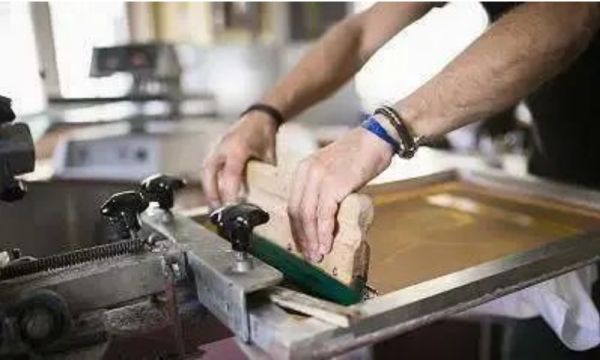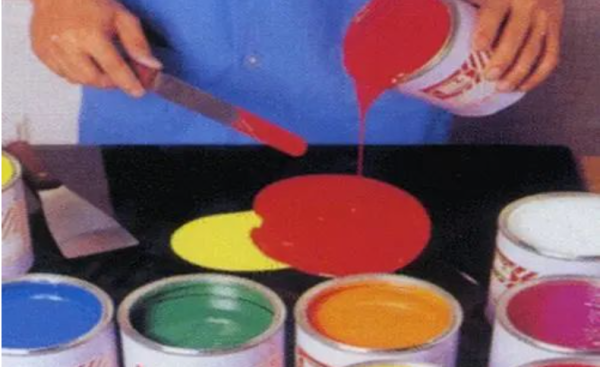Takeaway: silk screen as the manufacture of cosmetics packaging materials are very common graphic printing process, through the combination of printing ink, screen printing scree1n, screen printing equipment, make the ink through the graphic on the part of the mesh is transferred to substrates, in the process, screen printing color change will be influenced by some factors, this paper share several factors affecting the printing color change, content for friends reference:

Screen printing process is the ink through part of the screen screen after leakage on the substrate, the rest of the screen screen is blocked, the ink can not pass through. Printing ink poured on the screen, in no external force under the action of the ink will not leak through the screen to the substrate, and when the scraper with a certain pressure and tilt Angle scraping ink, it will be transferred to the following substrate through the screen to achieve image replication.
01 Ink Mixing
Assuming that the pigment in the ink is properly deployed, then, the usual reason for the color change is the addition of the solvent. In a well-controlled workshop, ink should be available to the press when it is ready, that is, the printer should not mix ink. In many companies, ink is not tuned for the press, but is left to the printer, who adds and mixes ink as he sees fit. In this way, the pigment balance in the ink is broken. For water-based ordinary ink or UV ink, the water in the ink in the same way as the solvent in the solvent ink, adding water will make the dry ink film thin, and affect the color of the ink, and then reduce the density of the color. The causes of such problems can be traced further.

In the ink warehouse, ink matching workers do not use weighing devices, only rely on their own judgment to add the right amount of solvent, or at the beginning of the mixing is not appropriate, or in the printing of the ink mixing amount, so that the mixed ink will produce different colors. When the live piece is printed again later, the situation becomes worse, and it is almost impossible to reproduce a color unless adequate ink ratios are recorded.
02 Screen Selection
Wire mesh diameter and weaving way, namely plain or twill, printing ink film thickness has a great impact. Screen suppliers will provide detailed technical information screen, one of the most important theoretical ink volume, it represents the amount of ink through the mesh under certain printing conditions, generally expressed by CM3 /m2. For example, a 150 mesh/cm screen with a mesh diameter of 31μm will pass through 11cm3/m2 of ink. A screen diameter of 34μm, 150 mesh screen, per square meter will pass through 6cm3 of ink, equivalent to 11 and 6μm thick wet ink layer. It can be seen that 150 mesh this simple representation, will make you get significantly different ink layer thickness, the result will cause a great difference in color.
With the improvement of screen weaving technology, to get a certain number of twill screen rather than plain screen, although it is sometimes possible, but the possibility is very small. Sometimes screen suppliers store some old twill screen, generally speaking, the theoretical ink volume of these screens have 10% change. If you use twill woven screen printing of fine level of image, the phenomenon of fine line fracture is more than using plain screen.
03 Screen Version of Tension
The lower tension of the screen will lead to slow separation of the screen from the printed surface, which will affect the ink that stays on the screen, and the effect of uneven color, so that the color appears to change. To solve this problem, it is necessary to increase the screen distance, that is, increase the distance between the horizontal screen plate and the printing material. Increasing the net distance means increasing the pressure of the scraper, which will affect the amount of ink through the screen, leading to further changes in color.
04 Setting of Scraper
The softer the scraper used, the more ink will pass through the screen. The greater the pressure on the scraper, in printing, scraper blade wear will be faster, which will change the scraper and print contact point, which will also change the amount of ink through the screen, resulting in color changes. Change the angle of scraping ink will also affect the amount of ink adhesion. If the scraper runs too fast, this will reduce the thickness of the ink layer attached.
05 Back to the Ink Knife Setting
The function of the ink knife is to make the screen hole filled with a stable amount of ink. Adjusting the pressure, Angle and sharpness of the ink knife will make the net hole too much or too little ink. Back ink knife pressure is too large, will force ink through the mesh, resulting in ink attachment too much. Inking knife pressure is not enough, will cause mesh only partially filled ink, resulting in insufficient ink attachment. The running speed of the ink knife is also very important. If it runs too slowly, the ink will overflow. If it is run too fast, it will cause severe ink deficiency, similar to the effect of changing the speed of the scraper.
06 Machine Setting
Careful process control is the most critical factor. The stable and consistent adjustment of the machine means the stable and consistent color. If the machine adjustment is variable, then the color can get out of control. This problem usually occurs when the printer changes shifts, or later when the printer changes the Settings on the press to suit his or her own habits, which can cause color changes. The latest multicolor screen presses eliminate this possibility with automatic computer control. These stable, consistent adjustments are to be made to the press and are to be maintained throughout the printing operation.
07 Printing Materials
An often overlooked aspect of the screen printing industry is the consistency of the substrate material to be printed. Paper, cardboard and plastic used in printing are generally produced in batches. A high quality supplier can guarantee a good surface smoothness for the whole batch of materials supplied, but this is not always the case, and any small change in the process can change the color and surface finish of these materials. Once this happens, the color of the print appears to change, even though nothing is actually changed during the printing process.
These are the practical difficulties that printers encounter when advertising a single image on a variety of materials, from corrugated plastic to fine art board. Another problem we often encounter is that our screen printing to catch up with offset printing images, if we do not pay attention to process control, we do not have a chance. Careful process control involves accurate color determination, line color determination with a spectrophotometer, and primary color determination with a densitometer, so that people can print images with stable and consistent colors on a variety of materials.
08 Light Source
that the pigment used for blending inks is exactly the same color throughout the printing operation. This could be a disaster if you switch suppliers. Color determination and perception is a very complex area, and for best control there must be a closed loop of the ink manufacturer, dispensing, proofing and accurate determination during the printing process.
09 Dry
Sometimes the color changes due to improper adjustment of the dryer. Printing paper or cardboard, if the drying temperature is too high, the general situation is white yellow. The glass and ceramics industry is most troubled by color changes during drying or baking. The pigments used here change from printed to sintered. The color of these sinters is affected not only by the baking temperature, but also by oxidation or the decrease in air quality in the baking area.
Original Source: https://www.fzhgp.com/news/color-changes-of-screen-printing-are-these-factors-paid-attention-to/
Media Contact
Company Name: Fuzhou Huaguang Color Printing Co., Ltd.
Email: Send Email
Phone: 0086-15606999155
Address:Building 4, No. 20, Zhaoyu Road, Gaishan Town
City: Fuzhou
State: Fujian
Country: China
Website: https://www.fzhgcp.com/












